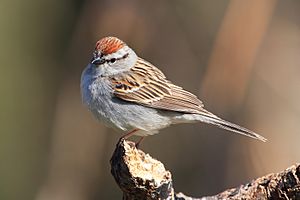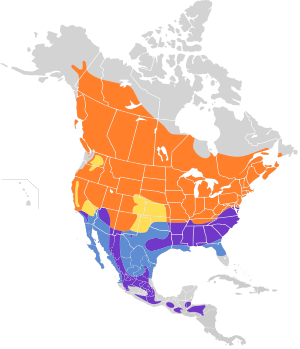Chipping sparrow facts for kids
Quick facts for kids Chipping sparrow |
|
|---|---|
 |
|
| Adult in breeding plumage | |
| Conservation status | |
| Scientific classification | |
| Genus: |
Spizella
|
| Species: |
passerina
|
 |
|
| Synonyms | |
|
Spizella socialis |
|
The chipping sparrow (Spizella passerina) is a small, common bird found across North America. It belongs to the New World sparrow family, Passerellidae. These birds are known for being quite friendly and easy to spot.
There are two main types, or subspecies: the eastern chipping sparrow and the western chipping sparrow. These birds are migratory, meaning they fly south for the winter. Birds from the northern parts of their range travel to Mexico and the southern United States. They return north when spring arrives.
Chipping sparrows change their feathers twice a year. When they are ready to breed, they have orangish-rust colored backs and gray heads and bellies. A bright reddish-brown cap on their head is a key feature. When they are not breeding, their cap turns brownish, and their face markings are less clear. Their song is a fast, buzzing trill. They also have a sharp flight call that you can hear when they fly at night during migration.
In winter, chipping sparrows often gather in groups. They might even join flocks with other bird species. They usually look for food on the ground, eating seeds and other small items. They also climb on plants and trees to find buds and tiny arthropods like insects. In the western parts of their range, they prefer to breed in coniferous forests. However, in the east, they choose woodlands, farms, parks, and even gardens. They start building nests in late April and May, often in trees.
Contents
Chipping Sparrow Appearance
Throughout the year, adult chipping sparrows have gray undersides and orangish-rust colored backs. When they are in their breeding plumage, they have a reddish-brown cap. They also have a clear white stripe above their eye and a black line running through their eye.
When they are not breeding, their markings are not as bright. Their cap is more brownish, their eyebrow stripe is duller, and the dark line through their eye is less noticeable.
Young chipping sparrows, called juveniles, have streaks on their undersides. Like non-breeding adults, they have a dark line through their eye. Their brownish cap and dull eyebrow can look different from one bird to another.
How Big Are Chipping Sparrows?
- Length: About 4.7 to 5.9 inches (12 to 15 cm)
- Weight: About 0.4 to 0.6 ounces (11 to 16 grams)
- Wingspan: About 8.3 inches (21 cm)
Chipping Sparrow Sounds
The chipping sparrow's song is a trill, which is a fast, repeated sound. This trill can sound different depending on the bird and where it lives. Some birds sing a "fast trill," which sounds like a buzz or snoring. Others sing a "slow trill," which sounds more like quick finger-tapping. Each part of the trill sounds like a high-pitched chi chi chi call.
You can hear the chipping sparrow's flight call all year long. This call is a sharp, clear sound that lasts for about 50 milliseconds. It starts high, drops lower, then goes high again. You might describe it as sounding like seen?. Chipping sparrows fly at night during migration. Their flight calls are a common sound in the night sky during spring and fall in the United States. In some areas, like the southern Rockies, they are one of the most common birds heard migrating at night.
Chipping Sparrow Types
Chipping sparrows look and act a little different across North America. Experts often group them into two main types: the eastern chipping sparrow and the western chipping sparrow. However, there are even more small differences within the western group.
In western North America, there are at least two subspecies. One is called Spizella passerina arizonae. This type lives in mountains and dry areas. Another type, S. p. stridula, lives along the Pacific coast. Even though both are "western," they might not be a single group separate from the eastern chipping sparrow (S. p. passerina).
The chipping sparrow belongs to the family Passerellidae. It is not closely related to the "Old World sparrows" that belong to the family Passeridae.
Chipping Sparrow Breeding Habits
Male chipping sparrows begin to arrive at their breeding areas from March (in warmer southern places like Texas) to mid-May (in northern areas like Alberta). Females arrive one to two weeks later. The male starts singing right away to attract a mate. After a pair forms, they begin building a nest about two weeks after the female arrives. The breeding season generally lasts from March until about August.
Chipping sparrows build their nests in grassy, open woodlands or fields with shrubs. The nest is usually built in a tree or bush, often a young, thick coniferous tree. It is typically about 1 metre (3.3 ft) off the ground, but always below 6 metres (20 ft). The female builds the nest in about four days. It is a loose platform made of grass and roots, with a soft inner cup of plant fibers and animal hair.
A female chipping sparrow lays a clutch of two to seven eggs. The eggs are pale blue to white with black, brown, or purple spots. They are about 17 by 12 millimetres (0.67 by 0.47 in) in size. The female sits on the eggs to keep them warm for 10 to 15 days. Sometimes, another bird called a brown-headed cowbird lays its eggs in the chipping sparrow's nest. This often causes the chipping sparrows to leave their nest.
What Chipping Sparrows Eat
Chipping sparrows eat seeds all year round. However, during the breeding season, insects make up most of their diet. They sometimes eat spiders too. In spring, they especially like seeds from dandelions (Taraxacum officinale). They also eat seeds from plants like Fallopia convolvulus, Melilotus species, Stellaria media, Chenopodium album, and Avena species.
Throughout the year, chipping sparrows look for food on the ground. They often search in areas with cover, like near the edges of fields.
See also
 In Spanish: Chimbito común para niños
In Spanish: Chimbito común para niños




